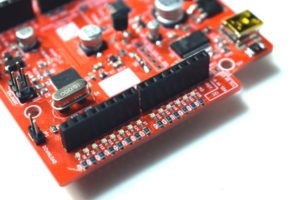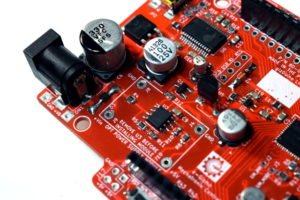gizDuino LIN-UNO Sneak Preview

Introducing gizDuino LIN
gizDuino LIN is the latest of our ever growing Arduino compatible controller platform. It uses the same micro controller as the Arduino Uno R3 (ATMEGA328P + LIN SOC), and is 100% code compatible with the popular Arduino Uno board.

LIN
Local Interconnect Network LIN is a robust hardware and software serial network used to connect and communicate with automotive components. The gizDuino LIN is ready to connect with and control these devices.
Even if you do not plan to use LIN compliant devices, you can actually use the LIN physical interface and program it just like an ordinary UART port. This will allow you to connect remote serial devices using long wire runs if the system so requires (the Arduino does not like long wires on its bare UART port) and control more than one serial devices (e.g. Sensors, actuators) on a single, common UART channel. e-Gizmo will start producing kits that will take advantage of this feature. In fact, we already have one – the serial dot matrix display kit.
LED Indicators on All I/O Ports
Imagine having the ability to check the states of your gizDuino I/O with just a single glance, without the need to use of extra monitoring devices. You’ll know if any of the port is in HIGH or LOW state, somewhere in between, or pulsing, by just looking. It will make hardware debugging and troubleshooting a lot more easier and convenient. gizDuino LIN brings you that feature and convenience.
 All I/Os, including analog ports, are equipped with LED state monitors. These LEDs will quickly tell you the state each I/Os are in. It’s like having a logic probe permanently attached to each I/Os.
All I/Os, including analog ports, are equipped with LED state monitors. These LEDs will quickly tell you the state each I/Os are in. It’s like having a logic probe permanently attached to each I/Os.
All I/O ports are equipped with buffered LED indicators. Buffering ensures the LEDs will not burden the I/O, so much so the effect to each I/O is as if they are not even there. Without buffering, you will have to deal with unnecessary port usage restrictions as a result, like loosing the I/O internal pull up feature, introducing non linear impedance detrimental to ADC functions.

Connecting directly an LED on any I/O can results in unexpected behaviour. To prevent that from occurring, each LED are buffered (with a transistor circuit).
Compatible with Arduino Uno R3
This is worth repeating here. Although the board uses a significantly different circuitry than the Arduino Uno R3, it is 100% code and board compatible with the Arduino Uno. The gizDuino LIN uses a System On Chip (SOC) that is essentially a ATMEGA328P with built-in LIN interface. Same core, from the same chip manufacturer (ATMEL/MicroChip). If your code runs on a Arduino Uno, it will run as well on a gizDuino LIN without any modification.
As a matter of fact, when connecting the board with the Arduino IDE, you can set the board selection as an Arduino Uno R3, and the IDE will happily recognise it as such.
Scalable power supply input
The standard version has an on board linear regulator that will work with external DC power input of up to 12VDC.
A low voltage option allows the gizDuino LIN to run on single cell (3.7V) Li-ion batteries. It has an on board DC to DC converter that generates a 5V supply from the 3.7V battery input. Great for battery operated projects.
A high voltage option allows the gizDuino LIN to function with up to 35V external DC power input.

Variants of gizDuino LIN with on-board DC/DC converters that will allow it to operate either in low voltage (i.e. 3.7V Li-ion battery) or high voltage power input will likewise be available.
Just one hardware difference that may require your attention
The gizDuino series, gizDuino LIN included, uses a different USB interface hardware compared with Arduino Uno.
Arduino Uno R3 uses a separate micro controller that act as bridge to convert the the Arduino UART signal into USB. The gizDuino, on the other hand uses a dedicated USB to UART device – the industry proven PL2303, to connect to a PC USB host for program downloading.
On a LINUX , Mac OS, or Windows 10 (and Up) machine, this difference won’t probably matter, as the operating system can correctly recognize this chip and will automatically install the correct drivers without needing your intervention. But on earlier versions of Windows OS, you may need to manually install the correct PL2303 drivers, as the OS seems to always pick the wrong drivers. You only need need to do this once – on the very first time you plug any gizDuino with your PC. And it is easy. Once installed, any gizDuino variant will connect on this PC exactly like a Arduino. A separate article that describes this in detail can be found here.
gizDuino LIN is undergoing its final pre-production evaluations. It will be available by the middle of June this year.



















1 Comment(s)
pwede po bang gamitin ito as Gateway?
Leave a Comment